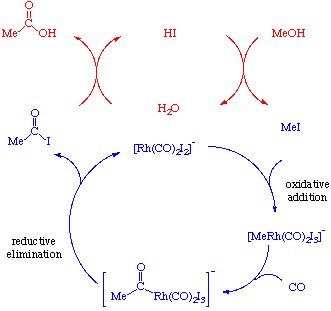
The Monsanto acetic acid process is the major commercial production method for acetic acid. Methanol, which can be generated from synthesis gas ("syn gas", a CO/H2 mixture), is reacted with carbon monoxide in the presence of a catalyst to afford acetic acid. In essence, the reaction can be thought of as the insertion of carbon monoxide into the C-O bond of methanol, i.e. the carbonylation of methanol.

This process has largely replaced an earlier synthetic method called the Wacker process. Over 1,000,000 tons of acetic acid are produced every year using the Monsanto process. The reaction is highly selective, goes in high yield, and is extremely fast. See Adv. Organomet. Chem. 1979, 17, 255 for a good review.
The catalyst system has two components, iodide and rhodium. Almost any source of Rh and I- will work in this reaction as they will be converted to the actual catalyst, [Rh(CO)2I2]- under the reaction conditions.
The role of iodide is simply to promote the conversion of methanol to methyl iodide, the species which then undergoes reaction with the Rh metal catalyst:

Once methyl iodide has been generated, the catalytic cycle begins with the oxidative addition of methyl iodide to [Rh(CO)2I2]-. Coordination and insertion of carbon monoxide leads an intermediate 18-electron acyl complex which can then undergo reductive elimination to yield acetyl iodide and regenerate our catalyst:

Notice that there are two catalytic cycles going in this reaction. The blue one involves the metal and the red one involves iodide. The acetyl iodide produced in the lower cycle is then hydrolyzed in the upper one to give acetic acid. This hydrolysis produces HI which can then convert more methanol to iodide and continue the cycle:

In summary, the system is catalytic in both Rh and I-.